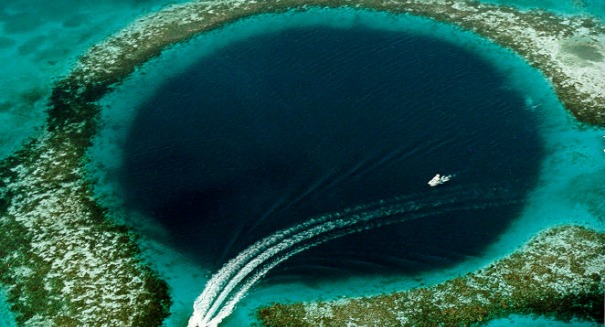
After extracting minerals from the caves of the Blue Hole, scientists have found the answer they suspected all along: a terrible drought wiped the Mayans out centuries ago.
The spectacular “Great Blue Hole” that sits off the coast of Belize is nearly 1,000 feet wide and plunges to depths of greater than 400 feet, and it holds an ancient secret — not of some great sea monster living deep below, but of the extinction of the once-great Mayan civilization.
Scientists found minerals in the Great Blue Hole that show that the region suffered an extreme drought in the 9th century that happened at about the same time as the Mayan civilization began to disintegrate. When they moved north and the rains returned, they disappeared again after a few centuries, the minerals showed that there had been another drought around that time, according to Discovery News.
It’s not the first time scientists have suggested that droughts were what ultimately doomed the Mayan culture, but this is the first hard evidence that the dry periods were responsible since they came from several spots in the Mayan region, according to Andre Droxler, co-author of the study and a scientist at Rice University.
The Mayans rules the Yucatan peninsula in modern-day Mexico from 300 to 700 A.D., building stone pyramids that draw many visitors today, as well as producing their own systems of writing and astronomy. They also produced a calendar that some thought heralded the end of the world in 2012.
But after 700, things began to disintegrate for the Mayans as warfare and anarchy became the norm, which may have been caused by everything from an increased fear of evil spirits to deforestation for expanding cropland to the loss of the Tikal deer, a favorite food of Mayans, according to the report.
The idea of a drought eventually doing the Mayans in was first proposed in 1995. In 2012, a study was published in Science that indicated a 2,000-year-old stalagmite in a cave in Belize showed rainfall had decreased considerably during the Mayans’ decline, but because it came from just one cave, scientists couldn’t be sure it applied to the whole region.
The latest discovery from the Blue Hole, however, suggests that the drought was indeed widespread.
Now, the question is where the drought came from. Scientists believe that it may have been because of a shift in the intertropical convergence zone (ITCZ), which is a weather system that brings a large amount of rain to tropical areas around the world during the summer, and then travels south during the winter. Such a shift in the weather system could have caused it to entirely miss the Yucatan peninsula, drying it out and devastating the Mayan people.
The Mayans should not be confused with the Aztecs, a more recent culture that ruled Mesoamerica between the 14th and 16th centuries. The Aztec Empire was conquered by Spanish conquistadors led by Hernando Cortes when he landed on the Gulf Coast in 1519.
The Great Blue Hole is an underwater sinkhole that is sometimes called a vertical cave. There are a number of “blue holes” around the world, but the Great Blue Hole is one of the largest and most notable. Others can be found near the Bahamas, Guam, Australia, and Egypt. Their deep, dark blue waters provide a spectacular contrast to the light blue of the shallow waters around them, and they make popular diving spots.
The Great Blue Hole is not even close to the deepest. That honor belongs to the Pozzo del Merro in Italy, which is more than three times as deep at 1,286 feet.

[…] What destroyed the Mayans? Belize’s spectacular Great Blue Hole holds the answer, scientists say – In 2012, a study … Yucatan peninsula, drying it out and devastating the Mayan people. The Mayans should not be confused with the Aztecs, a more recent culture that ruled Mesoamerica between the 14th and 16th centuries. The Aztec Empire was … […]